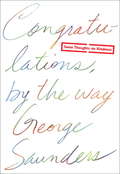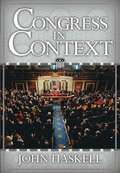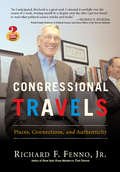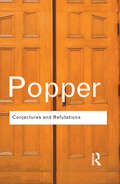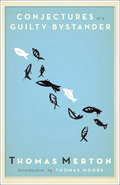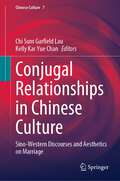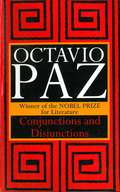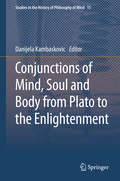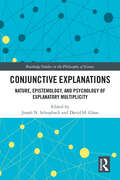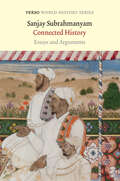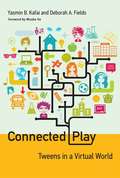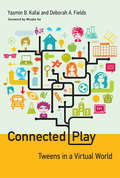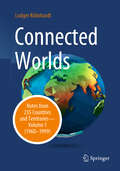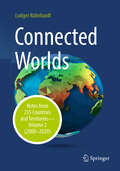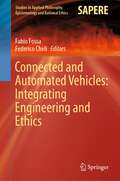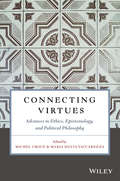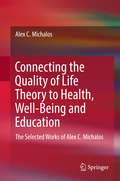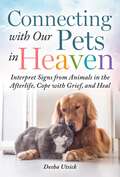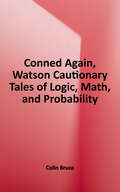- Table View
- List View
Congratulations, by the way: Some Thoughts on Kindness
by George SaundersThree months after George Saunders gave a convocation address at Syracuse University, a transcript of that speech was posted on the website of The New York Times, where its simple, uplifting message struck a deep chord. Within days, it had been shared more than one million times. Why? Because Saunders's words tap into a desire in all of us to lead kinder, more fulfilling lives. Powerful, funny, and wise, Congratulations, by the way is an inspiring message from one of today's most influential and original writers.From the Hardcover edition.
Congress in Context
by John HaskellThe U.S. Congress is by far the least popular branch of the federal government. It is also probably the least understood. It is not uncommon for high-ranking government officials to be confused about the workings of the institution and how it exercises its power. This book aims to demystify the institution-to give readers a succinct yet sophisticated overview of Congress and the policymaking process. Instead of treating Congress as an entity isolated from the rest of government, Congress in Context introduces readers to Congress's critical role as part of an interdependent system. Using the metaphor of Congress as a board of directors, author John Haskell explains the three key roles of Congress within the federal government-authorizing what government does, funding its activities, and, when it sees fit, supervising or "conducting oversight" on those activities. Grounded in current political science literature and packed with real-life examples, Congress in Context offers readers an informed and practical understanding of policymaking in the legislative branch.
Congress in Context
by John Haskell Marian Currinder Sara A. GroveThe U. S. Congress is by the far the least popular--and most misunderstood--branch of the federal government. Congress in Context de-mystifies the institution, giving students a comprehensive and practical understanding of Congress and the legislative process. This book takes a different approach to the study of Congress than other texts. Usually Congress is treated in isolation from the rest of the government. But the Framers of the Constitution explicitly intended for the branches of government to be interdependent. Congress in Context introduces readers to Congress’s critical role in the context of this interdependent system. Using the metaphor of a board of directors, the authors explain the three key roles of Congress within the federal government--authorizing what government does, funding its activities, and supervising how it carries out the laws Congress passes--and shows students how Congress interacts with the rest of the government to exercise these powers. The thoroughly expanded and revised second edition features brand-new chapters on Congress and the courts and Congress and interest groups. It also includes expanded coverage of Congress’s relationship with the executive branch, campaign finance, and today’s major budget issues. Grounded in the latest political science literature coupled with contemporary examples, Congress in Context offers students an informed yet accessible introduction to how the legislative branch carries out its duties.
Congress in Context
by John HaskellA concise and engaging introduction to the workings of Congress, from directing government actions through legislation and oversight to interacting with the executive branch in a separated system of government.
Congressional Travels: Places, Connections, and Authenticity
by Richard FennoA follow up book to his classic Home Style: House Members in their Districts, this new book by the preeminent legislative studies scholar, Dick Fenno, is intended for use in courses on Congress, political campaigning, and American government. Written in Fenno’s “homespun” story-telling style, this book argues that authenticity — knowing what a representative is like in his/her district and looking beyond mere roll call voting — contributes significantly to understanding the full body of work done by our members of Congress. It further posits, by recounting Fenno’s actual life’s work, that the best way to gain a sense of authenticity is to do what Fenno is most famous for — i.e., making multiple trips and spending a great deal of time observing representatives at home, with their constituents, in their districts. The book is an engaging, quietly provocative, and unique title that offers an alternative to what some consider the increasingly specialized and technical nature of political science
Conjectures and Refutations: The Growth of Scientific Knowledge
by Karl PopperConjectures and Refutations is one of Karl Popper's most wide-ranging and popular works, notable not only for its acute insight into the way scientific knowledge grows, but also for applying those insights to politics and to history. It provides one of the clearest and most accessible statements of the fundamental idea that guided his work: not only our knowledge, but our aims and our standards, grow through an unending process of trial and error.
Conjectures of a Guilty Bystander
by Thomas MertonIn this series of notes, opinions, experiences, and reflections, Thomas Merton examines some of the most urgent questions of our age. With his characteristic forcefulness and candor, he brings the reader face-to-face with such provocative and controversial issues as the “death of God,” politics, modern life and values, and racial strife–issues that are as relevant today as they were fifty years ago. Conjectures of a Guilty Bystanderis Merton at his best–detached but not unpassionate, humorous yet sensitive, at all times alive and searching, with a gift for language which has made him one of the most widely read and influential spiritual writers of our time.
Conjectures of a Guilty Bystander
by Thomas Moore Thomas MertonIn this series of notes, opinions, experiences, and reflections, Thomas Merton examines some of the most urgent questions of our age. With his characteristic forcefulness and candor, he brings the reader face-to-face with such provocative and controversial issues as the "death of God," politics, modern life and values, and racial strife-issues that are as relevant today as they were fifty years ago. Conjectures of a Guilty Bystander is Merton at his best-detached but not unpassionate, humorous yet sensitive, at all times alive and searching, with a gift for language which has made him one of the most widely read and influential spiritual writers of our time.From the Trade Paperback edition.
Conjectures of a Guilty Bystander
by Thomas Moore Thomas MertonIn this series of notes, opinions, experiences, and reflections, Thomas Merton examines some of the most urgent questions of our age. With his characteristic forcefulness and candor, he brings the reader face-to-face with such provocative and controversial issues as the "death of God," politics, modern life and values, and racial strife-issues that are as relevant today as they were fifty years ago. Conjectures of a Guilty Bystander is Merton at his best-detached but not unpassionate, humorous yet sensitive, at all times alive and searching, with a gift for language which has made him one of the most widely read and influential spiritual writers of our time.From the Trade Paperback edition.
Conjugal Relationships in Chinese Culture: Sino-Western Discourses and Aesthetics on Marriage (Chinese Culture #7)
by Kelly Kar Yue Chan Chi Sum Garfield LauThis book reviews the presentation of conjugal relationships in Chinese culture and their perception in the West. It explores the ways in which the act of marriage is represented/misrepresented in different literary genres, as well as in cultural adaptations. It looks at the gendered characteristics at play that affect conjugal relationships in Chinese societal practices more widely. It also distinguishes between the essential features that give rise to nuptial arrangements from the Chinese perspective, looking at what in which Sino and/or Western mentalities differ in terms of notions of autonomy in marriage. It excavates the extent to which marriage is constituted in forms of transaction between female and male bodies and asks under what circumstances wedding ceremonies constitute archetypal or counter-archetypal notions in pre-modern and modern society. Authors cover a range of fascinating cultural topics, such as posthumous marriage (necrogamy) as an ancient and popular folk culture from the perspective of Confucian ideology, as well as looking at marriage from ancient to present times, duty and rights in conjugal relations, inter-racial and inter-cultural marriage, widowhood in Confucian ideology, issues of legitimacy in marriage and concubinage, the taboos surrounding divorce and re-marriage, and conjugal violence. The book serves to revisit the cultural connections between marriage and various art forms, including literature, film, theatre, and other adaptations. It is a rich intellectual resource for scholars and students researching the historical roots, cultural interpretations, and evolving aspects of marriage as shown in literature, art, and culture.
Conjugal Union: What Marriage Is and Why It Matters
by Patrick Lee Robert P. GeorgeThis book defends the conjugal view of marriage. Patrick Lee and Robert P. George argue that marriage is a distinctive type of community: the union of a man and a woman who have committed to sharing their lives on every level of their beings (bodily, emotionally, and spiritually) in the kind of union that would be fulfilled by conceiving and rearing children together. The comprehensive nature of this union, and its intrinsic orientation to procreation as its natural fulfillment, distinguishes marriage from other types of community and provides the basis for the norms of marital exclusivity and permanence. Lee and George detail how the basic moral norms regarding sexual acts follow from the ethical requirement to respect the good of marriage and explain how the law should treat marriage, given its conjugal nature, examining both the same-sex-marriage issue and civil divorce.
Conjunctions and Disjunctions
by Octavio PazFascinated by the polarity of being, Paz has boldly attempted to write a "history of man". Unlike countless other histories that simply chronicle civilizations and cultures, Paz's work explores the human heart, the meaning of human nature, and the duality that exists within all beings.
Conjunctions of Mind, Soul and Body from Plato to the Enlightenment (Studies in the History of Philosophy of Mind #15)
by Danijela KambaskovicThis book examines the nexus between the corporeal, emotional, spiritual and intellectual aspects of human life as represented in the writing of the Middle Ages and the Renaissance. Authors from different fields examine not only the question of the body and soul (or body and mind) but also how this question fits into a broader framework in the medieval and early modern period. Concepts such as gender and society, morality, sexuality, theological precepts and medical knowledge are a part of this broader framework. This discussion of ideas draws from over two thousand years of Western thought: from Plato in the fifth century BC and the fourth century Byzantine dialogues on the soul, to the philosophical and medical writings of the early 1700s. There are four sections to this book: each section is based on where the authors have found a conjunction between the body and mind/soul. The work begins with a section on text and self-perception, which focuses on creative output from the period. The second conjunction is human emotions which are described in their social contexts. The third is sex, where the human body and mind are traditionally believed to meet. The fourth section, Material Souls, engages with bodies and other material aspects of existence perceived, studied or utilised as material signs of emotional and spiritual activity.
Conjunctive Explanations: The Nature, Epistemology, and Psychology of Explanatory Multiplicity (Routledge Studies in the Philosophy of Science)
by David H. Glass Jonah N. SchupbachPhilosophers and psychologists are increasingly investigating the conditions under which multiple explanations are better in conjunction than they are individually. This book brings together leading scholars to provide an interdisciplinary and unified discussion of such “conjunctive explanations.” The book starts with an introductory chapter expounding the notion of conjunctive explanation and motivating a multifaceted approach to its study. The remaining chapters are divided into three parts. Part I includes chapters on “The Nature of Conjunctive Explanations.” Each chapter illustrates distinct ways in which explanatory multiplicity is motivated by a careful study of the nature and concept of explanation. The second part (“Reasoning About Conjunctive Explanations”) includes chapters on the epistemology and logic of conjunctive explanations. Here the contributors propose and evaluate various norms for reasoning correctly about and to conjunctive explanations. Part III concerns “The Psychology of Conjunctive Explanations,” with contributions discussing conditions under which humans entertain and hold multiple explanations of single explananda simultaneously and the cognitive limitations and capacities for doing so. Conjunctive Explanations will be of interest to researchers and advanced students working on explanation in philosophy of science, epistemology, philosophical logic, and cognitive psychology.
Conjuring Moments in African American Literature
by Kameelah L. MartinThis book engages the ways African American authors have shifted, recycled, and reinvented the conjure woman in fiction. Kameelah Martin Samuel traces her presence and function in twentieth-century literature through historical records, oral histories, blues music, and collections of African American folklore.
Connected History: Essays and Arguments
by Sanjay SubrahmanyamA collection of essays that span many regions and cultures, by an award-winning historianSanjay Subrahmanyam is becoming well known for the same sort of reasons that attach to Fernand Braudel and Carlo Ginzburg, as the proponent of a new kind of history - in his case, not longue durée or micro-history, but 'connected history': connected cross-culturally, and spanning regions, subjects and archives that are conventionally treated alone. Not a research paradigm, he insists, it is more of an oppositionswissenschaft, a way of trying to constantly break the moulds of historical objects.The essays collected here, some quite polemical - as in the lead text on the notion of India-as-civilization, or another, assessing such a literary totem as V. S. Naipaul - illustrate the breadth of Subrahmanyam's concerns, as well as the quality of his writing. Connected History considers what, exactly, is an empire, the rise of 'the West' (less of a place than an idea or ideology, he insists), Churchill and the Great Man theory of history, the reception of world literature and the itinerary of subaltern studies, in addition to personal recollections of life and work in Delhi, Paris and Lisbon, and concluding remarks on the practice of early-modern history and the framing of historical enquiry.
Connected Play: Tweens in a Virtual World
by Yasmin B. Kafai Deborah A. FieldsMillions of children visit virtual worlds every day. In such virtual play spaces as Habbo Hotel, Toontown, and Whyville, kids chat with friends from school, meet new people, construct avatars, and earn and spend virtual currency. In "Connected Play," Yasmin Kafai and Deborah Fields investigate what happens when kids play in virtual worlds, how this matters for their offline lives, and what this means for the design of educational opportunities in digital worlds. Play is fundamentally important for kids development, but, Kafai and Fields argue, to understand play in virtual worlds, we need to connect concerns of development and culture with those of digital media and learning. Kafai and Fields do this through a detailed study of kids play in Whyville, a massive, informal virtual world with educational content for tween players. Combining ethnographic accounts with analysis of logfile data, they present rich portraits and overviews of how kids learn to play in a digital domain, developing certain technological competencies; how kids learn to play well -- responsibly, respectfully, and safely; and how kids learn to play creatively, creating content that becomes a part of the virtual world itself.
Connected Play: Tweens in a Virtual World (The John D. and Catherine T. MacArthur Foundation Series on Digital Media and Learning)
by Yasmin B. Kafai Deborah A. FieldsHow kids play in virtual worlds, how it matters for their offline lives, and what this means for designing educational opportunities.Millions of children visit virtual worlds every day. In such virtual play spaces as Habbo Hotel, Toontown, and Whyville, kids chat with friends from school, meet new people, construct avatars, and earn and spend virtual currency. In Connected Play, Yasmin Kafai and Deborah Fields investigate what happens when kids play in virtual worlds, how this matters for their offline lives, and what this means for the design of educational opportunities in digital worlds. Play is fundamentally important for kids' development, but, Kafai and Fields argue, to understand play in virtual worlds, we need to connect concerns of development and culture with those of digital media and learning. Kafai and Fields do this through a detailed study of kids' play in Whyville, a massive, informal virtual world with educational content for tween players. Combining ethnographic accounts with analysis of logfile data, they present rich portraits and overviews of how kids learn to play in a digital domain, developing certain technological competencies; how kids learn to play well—responsibly, respectfully, and safely; and how kids learn to play creatively, creating content that becomes a part of the virtual world itself.
Connected Worlds: Notes from 235 Countries and Territories - Volume 1 (1960-1999)
by Ludger KühnhardtThe notes that Ludger Kühnhardt wrote in 235 countries and territories around the world create a fascinating panorama, reflected in the personal impressions, encounters and experiences of a political scientist and journalist working all over the world. The book reconstructs the connections between Europe's transformations and the emerging global era over six decades from 1960 to the threshold of the post-Corona world of 2020.
Connected Worlds: Notes from 235 Countries and Territories - Volume 2 (2000-2020)
by Ludger KühnhardtThe diary notes that Ludger Kühnhardt took while visiting or staying in 235 countries and territories around the world create a fascinating panorama, reflected in the personal impressions, encounters and experiences of a political scientist and journalist working all over the world. The book reconstructs the connections between Europe's transformations and the emerging global era over six decades from 1960 to the threshold of the post-Corona world of 2020.
Connected and Automated Vehicles: Integrating Engineering and Ethics (Studies in Applied Philosophy, Epistemology and Rational Ethics #67)
by Federico Cheli Fabio FossaThis book reports on theoretical and practical analyses of the ethical challenges connected to driving automation. It also aims at discussing issues that have arisen from the European Commission 2020 report “Ethics of Connected and Automated Vehicles. Recommendations on Road Safety, Privacy, Fairness, Explainability and Responsibility”. Gathering contributions by philosophers, social scientists, mechanical engineers, and UI designers, the book discusses key ethical concerns relating to responsibility and personal autonomy, privacy, safety, and cybersecurity, as well as explainability and human-machine interaction. On the one hand, it examines these issues from a theoretical, normative point of view. On the other hand, it proposes practical strategies to face the most urgent ethical problems, showing how the integration of ethics and technology can be achieved through design practices. All in all, this book fosters a multidisciplinary approach where philosophy, ethics, and engineering are integrated, rather than just juxtaposed. It is meant to inform and inspire an audience of philosophers of technology, ethicists, engineers, developers, manufacturers, and regulators, among other interested readers.
Connecting Virtues: Advances in Ethics, Epistemology, and Political Philosophy (Metaphilosophy)
by Michel Croce Maria Silvia VaccarezzaConnecting Virtues examines the significant advances within the fast-growing field of virtue theory and shows how research has contributed to the current debates in moral philosophy, epistemology, and political philosophy. Includes groundbreaking chapters offering cutting-edge research on the topic of the virtues Provides insights into the application of the topic of virtue, such as the role of intellectual virtues, virtuous dispositions, and the value of some neglected virtues for political philosophy Examines the relevance of the virtues in the current debates in social epistemology, the epistemology of education, and civic education Features work from world-leading and internationally recognized philosophers working on the virtues today
Connecting the Quality of Life Theory to Health, Well-being and Education: The Selected Works of Alex C. Michalos
by Alex C. MichalosThis volume connects aspects of personal health, overall well-being, and education to quality of life. It includes discussions of Galen's and Harvey's views of the movement of blood in human bodies, and differences in the research traditions of social indicators research and health-related quality of life research. It examines determinants of health and quality of life in a variety of populations, including the residents of the Bella Coola Valley of British Columbia, aboriginal residential school survivors in Canada, and diabetics versus non-diabetics. It describes relations between health survey and patients' medical chart reviews, the health and quality of life of older people, and the difference between good health and a good life. Other topics explored are student quality of life, comparisons of the quality of life of students, aboriginal and unemployed people, the impact of education on happiness and well-being, and liberal education. In addition, the volume presents Einstein's views of ethics and science, and unacknowledged authorship in scholarly publications. The final chapter gives a historical review of quality of life research in Canada over the past fifty years.
Connecting with Our Pets in Heaven: Interpret Signs from Animals in the Afterlife, Cope with Grief, and Heal
by Desha UtsickAn A to Z guide of signs and symbols that show your best friends never really left your side.In many cases, we don&’t choose pets to welcome into our family; they choose us. Or some divine intervention seems to bring us together. That mysterious but amazing bond is not broken when an animal leaves our realm. Our pets continue to reach out to us in loving, encouraging, even instructing ways after they cross the rainbow bridge.This beautiful book, complete with inspiring photos, will share the many ways pets speak to us through signs in nature (cardinals, rainbows, clouds), patterns that pop up in our daily lives (from smudges on glass to pawprints on a path), familiar pet sounds (jangling tags or the voice of one pet through another), orbs, dreams, and more. Organized in an A-to-Z format by pet sign, you&’re sure to find a connection to pets who have been part of your family. Heart-warming personal stories from the author and other pet lovers share the promise that our animals and their love remain in our lives forever.
Conned Again, Watson: Cautionary Tales of Logic, Math, and Probability
by Colin BruceIn this book, the author re-creates the atmosphere of the original Sherlock Holmes stories to shed light on an enduring truth: Our reliance on common sense—and ignorance of mathematics—often get us into trouble. In these cautionary tales of greedy gamblers, reckless businessmen, and ruthless con men, Sherlock Holmes uses his deep understanding of probability, statistics, decision theory, and game theory to solve crimes and protect the innocent. But it's not just the characters in these well-crafted stories that are deceived by statistics or fall prey to gambling fallacies. We all suffer from the results of poor decisions. <p><p>In this illuminating collection, Bruce entertains while teaching us to avoid similar blunders. From "The Execution of Andrews" to "The Case of the Gambling Nobleman," there has never been a more exciting way to learn when to take a calculated risk and how to spot a scam.
